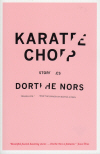Karate Chop
If the fifteen stories in Karate Chop, by Danish writer Dorthe Nors, were drawings, the spare lines would be punctuated by dark space filled with implication. Each tale is a visit to a foreign place from the viewpoint of an other, someone you might pass without noticing—a walker in the park, a woman getting a haircut, a teenage girl with her father in a car.
If the fifteen stories in Karate Chop, by Danish writer Dorthe Nors, were drawings, the spare lines would be punctuated by dark space filled with implication. Each tale is a visit to a foreign place from the viewpoint of an other, someone you might pass without noticing—a walker in the park, a woman getting a haircut, a teenage girl with her father in a car.
In the title story, a young woman analyzes her unsuccessful relationships with men. “She had once been advised to listen closely to what a man said just when he began to sense a woman was showing interest in him . . . important information about their true nature.” Looking back, she sees that she hadn’t understood a person could have self-knowledge and not wish to change. A child psychologist, she has been dating the father of a client. Now, bruised and wounded, she realizes he’d been frank with her about his disturbing traits. But she fell in love because of this frankness. The authorial camera pans back to reveal the bloody aftermath of this failure to protect the self. The protagonist compares her action to a girl-child coloring outside the lines beyond the need for approval and submission. The reader senses Nors’s frustration with fatalistic female passivity and the male capacity for violence. The story shocks because of how far she takes this.
In “Do You Know Jussi?” a young woman watches TV in her bedroom after her boyfriend has just gone home. The show is about a search for a person who has disappeared. “The son [on TV] is thirty, rather chubby, and nearly cries when he says he is not angry with his father. But he can’t understand why his father has not written to him.” The boyfriend hasn’t texted the girl yet. She thinks of the way he always tongue kisses. This reminds her of licking envelops at her Dad’s office as a child in competition. “The addresses were all for men and the addresses made her think about people to whom she didn’t belong.” She remembers imagining that one of these men would rescue her, taking her home in his imagined car. This fantasy is flat, devoid of romantic content but filled with disconnected longing. The young woman touches herself under her panties. “It still feels tender, but she thinks it will pass.” She still has not heard from the boyfriend, so she turns off her cell phone and goes to sleep. The reader feels the dry whisper of disappointment. At least the man on the TV could cry.
Nors leaves room for only the occasional half-smile, but the reader is on guard. In “The Buddhist,” a bureaucratic functionary, after a divorce, grows disillusioned with writing speeches for the foreign ministry and gradually realizes that he is “a Buddhist.”
It was more like the Buddhist, as an idea, crept up and settled in him. . . . The Buddhist came in and sat down at the opposite side of his desk. . . . He contemplated the Buddhist and thought it was a good format to step into. Buddhists are good people. They’re deeper than most. Buddhists can see connections no one else can. These were all qualities he recognized in himself . . .
Forced out of his job after writing a truth-telling article about lies in government, the new convert talks his way into running a Buddhist aid organization. He wants to do good: “the Buddhist has had the feeling for a long time that he is the kind of person who is able to grasp the meaning behind things . . . that the world needs a strong, solitary man to save it.” In a scathing satirical moment, he likens himself to Hitler, Nelson Mandela, and Mother Teresa and crosses from self-justifying narcissism into outright delusions of grandeur, which, of course, lead to disaster. Nors creates a historical archetype—though writ small, still deadly.
Violence courses through almost all of the stories: real, imagined, metaphorical, or all three at once. The narrative tone travels from dissociated grief toward distanced irony laced with anger, but there are softer moments. A daughter copes with her mother’s recurrent depression and her “fear of life . . . a kind of fear that took in the whole of people’s lives and could make them forsaken wherever in the world.” A handicapped man is one of those people who “look at their burns and bruises, their emptied bank accounts and broken dreams, as though it were an eternal source of astonishment to them that malice actually exists.” Nors describes so precisely the facets of vulnerability and self-delusion, as well as the high price that must be paid in life for self-protection.





